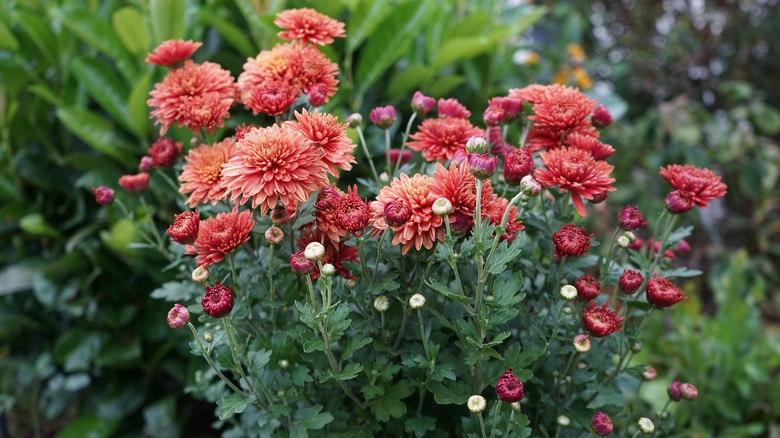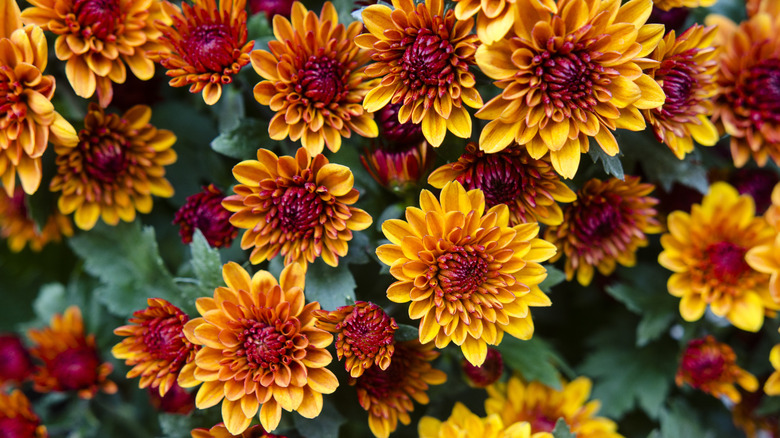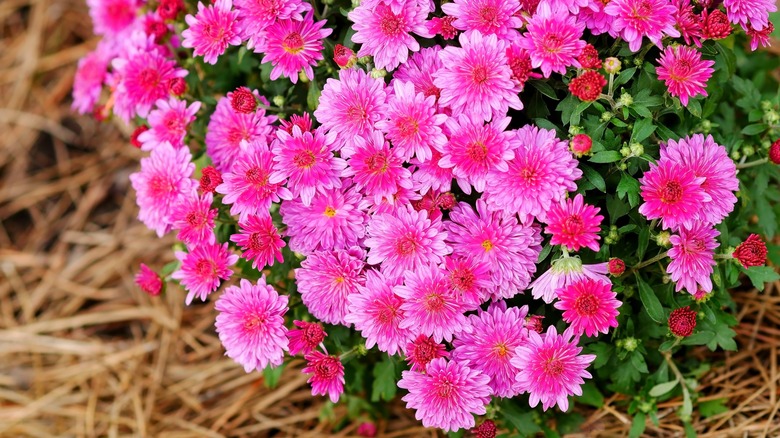The Best Time Of Year To Divide Your Garden Mums (And How To Do It)
Mums make wonderful perennials, offering gorgeous long-lived blooms beginning in late summer and continuing after frost. The blooms often last longer than the mums purchased as potted annuals, so if you have the space and a sunny spot, planting mums as returning perennials ensures a colorful addition to the late-season flower bed. Like all perennials, mums increase in size every year, and the clumps need dividing every so often. The best time to divide your mums is in the fall, although they can also be divided in early spring.
How often to divide your mums depends in part on how fast they grow. Some varieties form large clumps quickly, while others may increase more slowly. Let them put on some size before dividing them the first time: once the base of the clump is at least 6 inches across, you can divide them. Placing them throughout your garden and making sure they get full sun for the most vigorous blooms gives you a lovely palette of autumn color.
If you want to divide mums in spring, wait until the ground is soft enough to be worked. Gently divide the mums with a shovel or garden knife. It's important to be gentle when dividing mums in spring, as you don't want to damage any new growth. Once they're established, pinching back the leaves every couple of weeks throughout the spring helps keep them a bit more compact and increases the number of flower buds later.
How to divide mums
If your mums start to turn brown and slow their growth as late autumn approaches, it's a good time to divide them. You can keep trimming off spent flowers if new buds are forming, as they may continue to bloom even after frost. Check the weather forecast and try not to divide mums (or any perennials) if there is an imminent hard frost in your agricultural zone. Ideally, they should have at least a few days to acclimate to a new spot before the soil freezes. One or two nights of hard frost in November shouldn't be an issue.
There are two ways to divide mums. You can use your shovel to cut through the clump down to the roots and remove a section or a third or half of the plant. Or you can dig up the entire clump, cut or break it into parts, and replant the sections where you want them. In late fall, you may already see a bit of new growth starting to form from the roots of your mums, but it's also normal for the growth to go dormant at this time. This can depend on the variety, as the timing of bud formation and blooming can vary.
Before replanting the divided sections of your mum plant, clean up any debris, dead stems, or leaves. Prepare the new spot with fresh garden soil or some manure or compost. Cover over with soil, pat down firmly, and water the mums.
Where to plant mums after you divide them
If you have a lot of mums to divide, give some thought to where you want to plant them. Once they are allowed to perennialize in your garden, your mums may surprise you with how tall they get or how far they spread out. They can really help fill in bare spots in the garden if you give them proper placement. The most important requirement for mums is a spot with bright sunlight; they need at least 5 hours of full sun per day to really bloom at their best.
Some mums are compact clumps, some form a large round ball of blooms, and some might have long stems that meander along the ground. Keeping an eye on their growth habit will help you decide where to place them in your garden. Also, look at their color range. Mums may have buds that are a completely different color from their blooms (like yellow buds that turn into white flowers or dark red buds that open to orange flowers).
You may notice that, in addition to growing at different rates, perennial mums might grow much longer stems than potted greenhouse mums, and sometimes, the weight of the flowers may cause them to lean over rather than reach straight up. Consider placing these where they will mix with other perennials or near the front of the border where they can bloom in the late fall.


